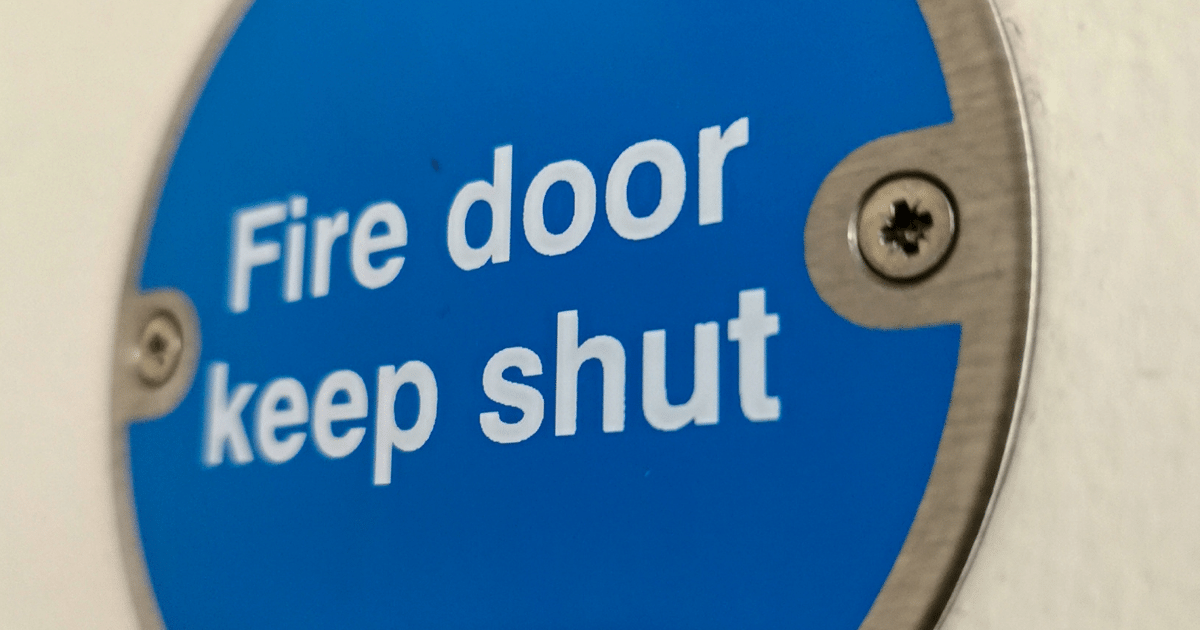Introduction
Robbie at Crucial Maintenance Services firmly believes that fire door inspection is a crucial safety aspect of any building, especially in multi-occupied residential buildings where the safety of numerous individuals is at stake. In light of recent incidents and recommendations from the Grenfell Tower Inquiry, regulations have been introduced in England to ensure the proper maintenance and inspection of fire doors.
This blog explores the legal requirements and the benefits of using a fire door inspection service in such buildings, please be aware that we are not solicitors and the information written is our interpretation of the laws, please consult a legal representative.
We have added links to the UK government documentation, they are highlighted in blue.

Legal Requirements
The Fire Safety (England) Regulations 2022, effective from 23rd January 2023, made it a legal obligation for responsible persons in multi-occupied residential buildings in England with storeys over 11 meters to undertake quarterly checks of all fire doors in the common areas. Additionally, responsible persons must perform annual checks, to the best of their abilities, on all flat entrance doors leading to the building’s common parts.
The regulations also mandate responsible persons to provide information to residents regarding the significance of fire doors in a building’s fire safety. This requirement aims to deepen residents’ understanding of the role they play in ensuring the safety of their building and encourages cooperation with the responsible persons.
The Regulatory Reform (Fire Safety) Order 2005 is a piece of legislation in the United Kingdom that came into force in October 2006. It is aimed at improving fire safety in non-domestic premises and common areas of multi-occupancy residential buildings. The order applies to a wide range of premises, including offices, shops, hotels, factories, warehouses, care homes, schools, and other public places.
The order places duties on the responsible person (usually the employer, owner, or occupier of the premises) to assess fire risks, take appropriate fire safety measures, and implement a fire management plan. The order requires the responsible person to:
The Fire Safety Order 2005 has been amended and updated over the years to ensure its effectiveness and relevance.
Fire doors are a critical component in preventing the spread of smoke, toxic gases, and fire within a building. They help maintain effective compartmentation, limiting the fire’s impact and providing valuable time for evacuation and emergency response. Properly functioning fire doors create barriers that restrict the movement of fire, smoke, and heat, enhancing the overall fire safety of the building.
Buildings covered: The Fire Safety (England) Regulations 2022 apply to all buildings that contain two or more domestic premises and have common parts through which residents would need to evacuate in the event of a fire. This includes all blocks of flats (or parts of such blocks) that incorporate common parts, regardless of whether the block is purpose-built or a conversion.
(The Regulatory Reform (Fire Safety) Order 2005 – the Fire Safety Order – provides a framework for regulating fire safety in all non-domestic premises including workplaces and the parts of multi-occupied residential buildings used in common in England and Wales)
Please note that this list is not exhaustive, and there may be other types of buildings covered as well. The provided text does not explicitly mention all the building types, so it’s important to refer to the relevant regulations and laws to confirm the complete scope of buildings covered.
The regulations require Responsible Persons, including building owners and those having control of the premises, to comply with the requirements.
Types of fire doors covered:
a. Flat entrance doors: These doors are crucial in preventing the spread of fire and smoke within the building. Most fires in blocks of flats occur within the flats themselves, so flat entrance doors play a critical role in ensuring the safety of other residents and preventing fire and smoke from reaching common areas.
b. Doors to stairways and lobbies: These doors are important in keeping stairways and lobbies free from fire and smoke to provide safe evacuation routes for residents and assist firefighters during emergencies.
c. Doors that sub-divide corridors: These doors are meant to limit the spread of fire and smoke along a corridor, preventing it from reaching other areas.
d. Doors to plant rooms and cupboards, and service risers: These doors are checked to ensure they resist the spread of fire and smoke and protect essential equipment and services in the building.
Routine checking of fire doors: The regulations require the Responsible Person to conduct routine checks of fire doors in buildings, depending on their height:
a. Flat entrance fire doors: Must be checked at least every 12 months.
b. Fire doors in communal areas (e.g., stairways, lobbies, corridors): Must be checked at least every 3 months.
Benefits of Using a Fire Door Inspection Service
Compliance with Legal Obligations:
Engaging a fire door inspection service ensures that responsible persons meet their legal requirements. By conducting regular inspections, they can demonstrate due diligence in maintaining fire safety measures in multi-occupied residential buildings. Compliance with regulations not only avoids potential legal penalties but also promotes a safer living environment for residents.
Enhanced Fire Safety:
Regular inspections identify any damage, issues, or faults in fire doors, allowing prompt repairs or replacements. This proactive approach ensures that fire doors are functioning optimally, minimizing the risk of fire spread and increasing the effectiveness of compartmentation. As a result, occupants have a higher level of protection in case of a fire, reducing potential injuries and property damage.
Peace of Mind for Residents:
When residents are aware that responsible persons are actively inspecting and maintaining fire doors, it instils confidence and peace of mind. They can feel reassured that the building’s fire safety measures are regularly assessed, and any deficiencies are promptly addressed. This knowledge promotes a sense of security and fosters trust between residents and responsible persons.
Early Detection of Issues:
Fire door inspections enable the identification of any problems or damage before they escalate. Timely repairs or replacements can be carried out, preventing minor issues from turning into major safety concerns. Detecting and resolving issues promptly reduces the likelihood of fire doors failing during an emergency, ensuring their effectiveness when it matters most.

Conclusion
The legal requirements introduced in England emphasize the importance of fire door inspections in multi-occupied residential, public and commercial buildings. By employing a professional fire door inspection service, responsible persons can fulfill their obligations, enhance fire safety, and promote the well-being of building occupants. Regular inspections provide peace of mind, early detection of issues, and a safer living environment.
It is crucial for all stakeholders to prioritize fire safety and work together to ensure the optimal performance of fire doors, thus safeguarding lives and property in the event of a fire.
The principal fire safety laws in England include:
These laws apply to most properties except single residential dwellings and place legal obligations on property owners and responsible persons, especially in multi-occupied residential buildings, workplaces, and public spaces. The regulations cover everything from the building’s external walls and structure to fire doors in common areas.
Key Fire Door Responsibilities:
Fire doors are crucial for containing fire, smoke, and toxic gases, and regular checks are mandatory to ensure they provide adequate protection. Compliance with these regulations ensures a safer environment for all occupants.
For more information, visit our blog for links to the official UK Government legislation.